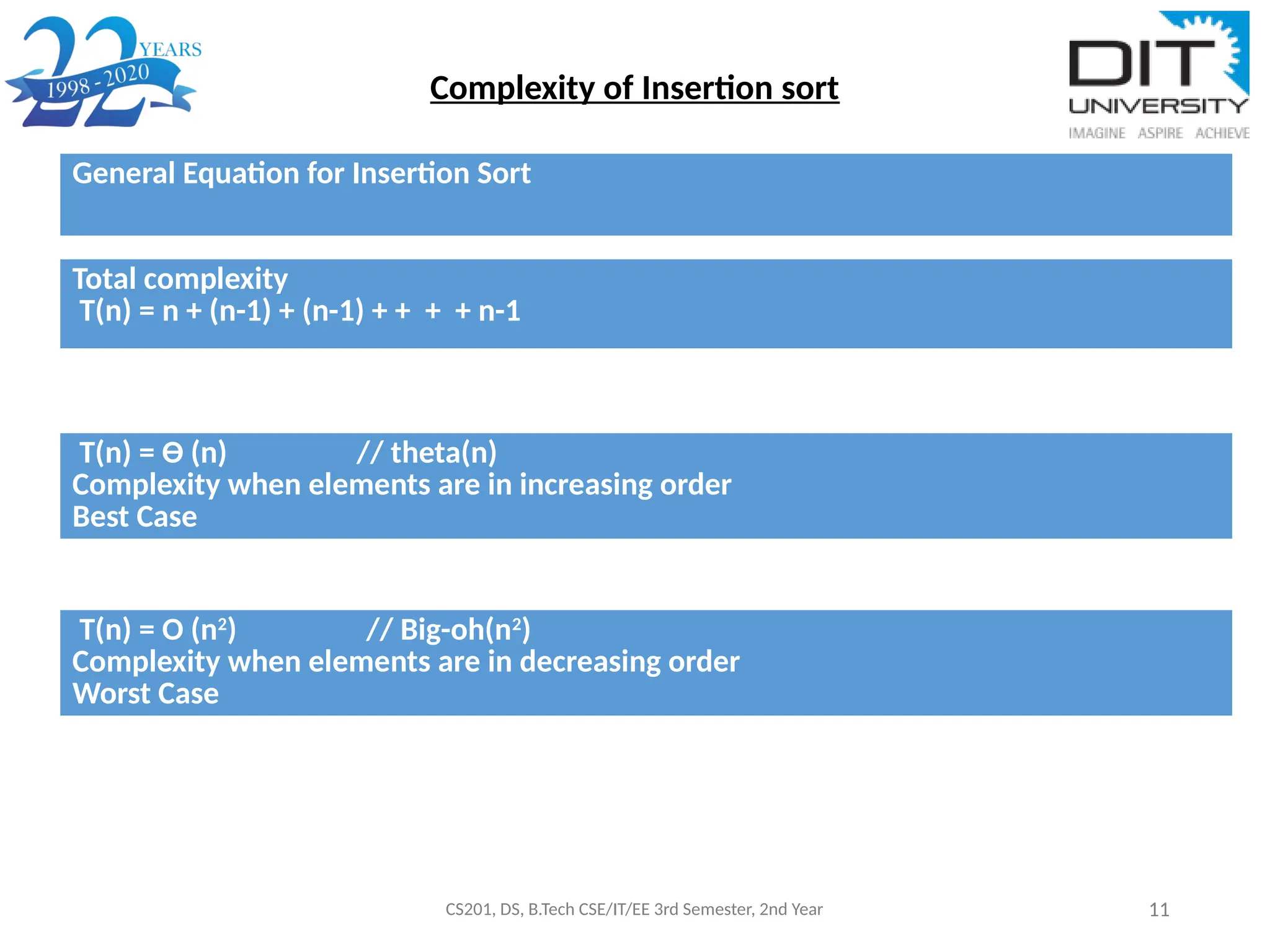The document discusses the complexity of algorithms, focusing on time and space complexity, particularly in relation to the insertion sort algorithm. It emphasizes the importance of analyzing the worst-case, average-case, and best-case scenarios to compare algorithm performance. Additionally, it provides a detailed examination of how the insertion sort algorithm behaves under different conditions of input order, calculating the corresponding time complexities.
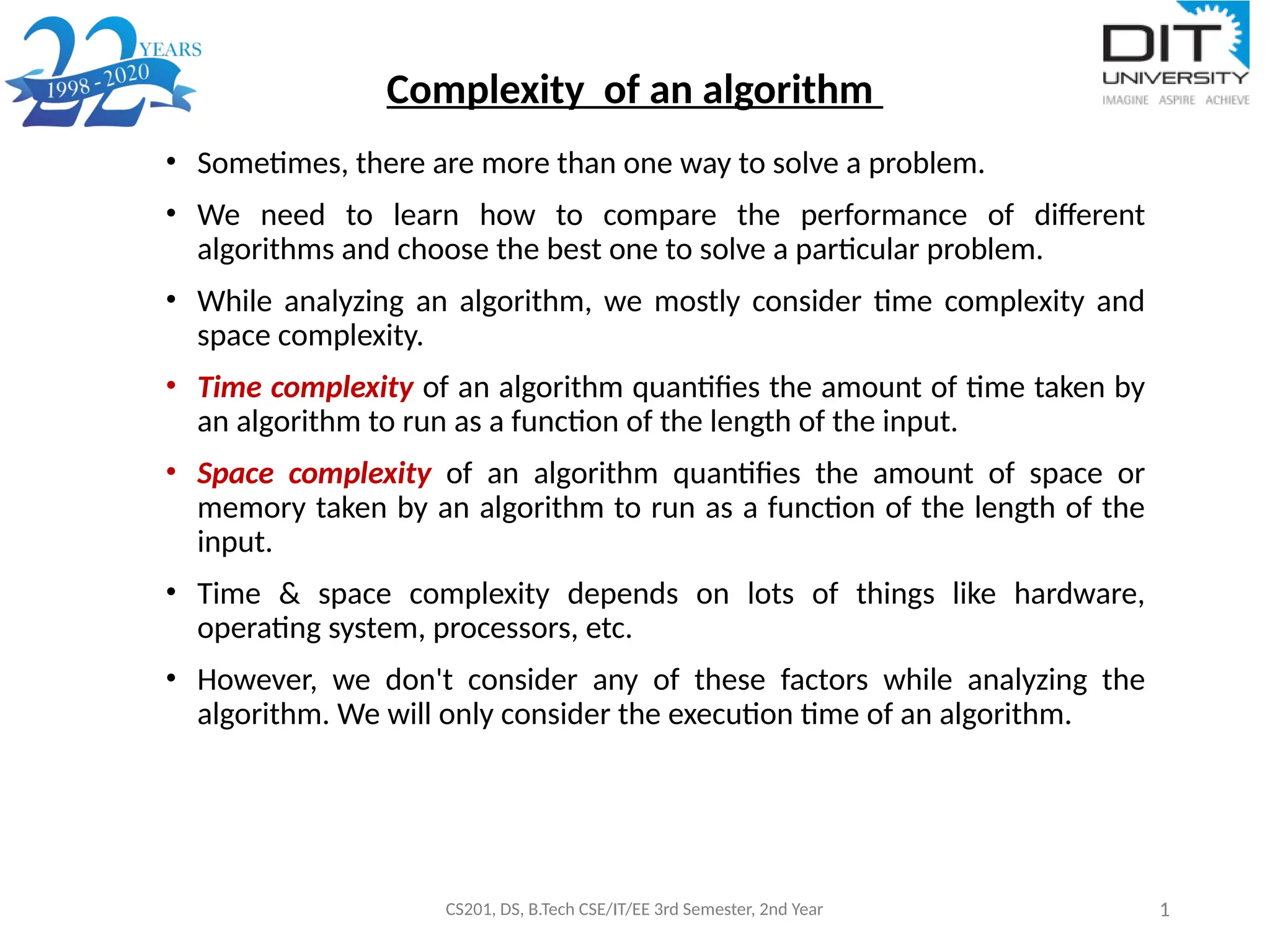
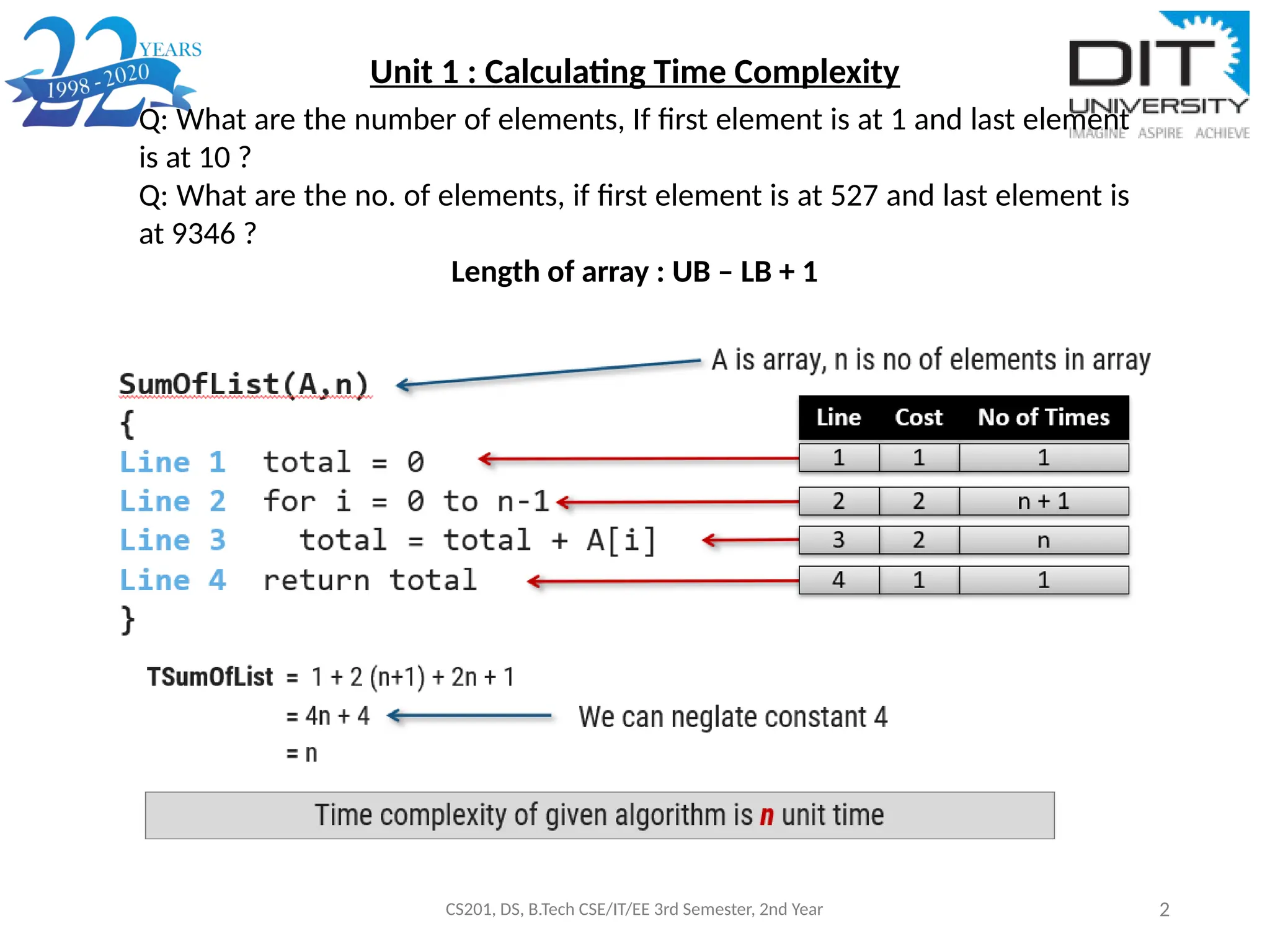
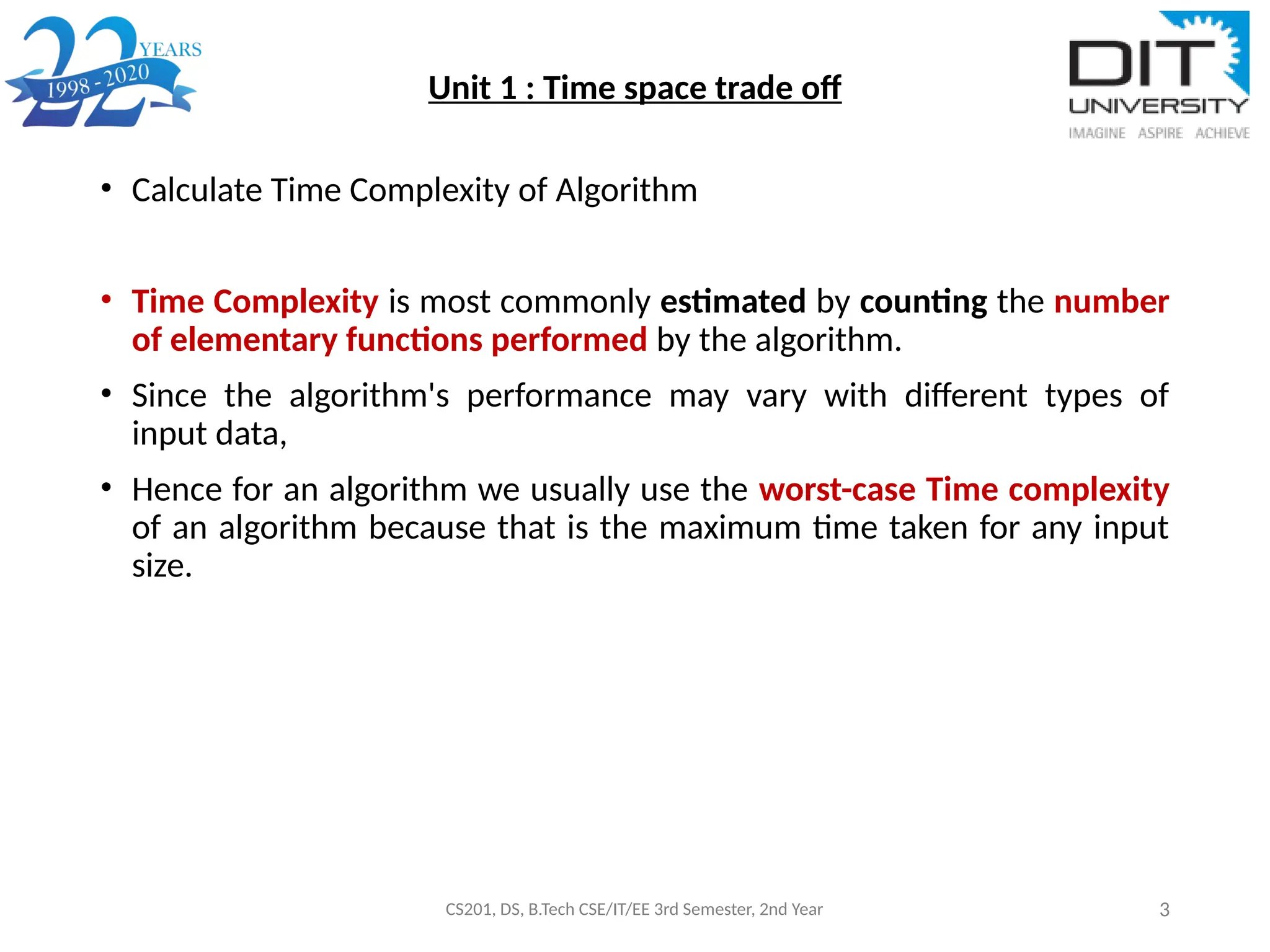
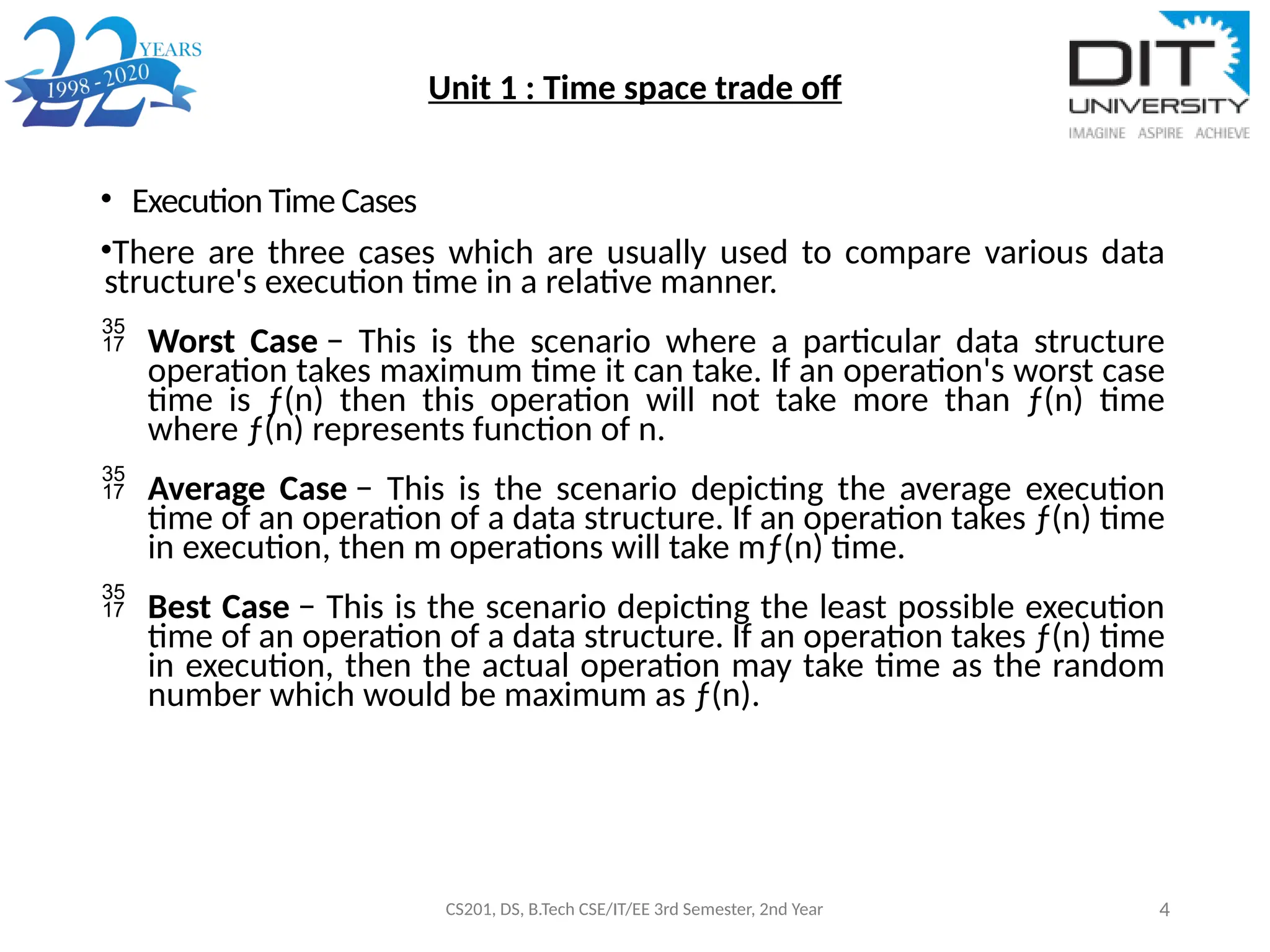
![Case of : Insertion sort & related questions
CS201, DS, B.Tech CSE/IT/EE 3rd Semester, 2nd Year 5
• Q1: What are the number of comparison required to insert 40? // fig : 1
• Hint : j = 4 , i = 3
• Answer : 2
• Q2: How many times the while loop execute?
• Answer : 2
• // for i= 3 condition is true
• // for i=2 condition is false
• Q3 : What are the number of comparison required to insert 25 ? // fig :2
• Hint : j = 5, i = 4
• Answer : 4
• Q4: How many times the while loop execute?
• Answer: 4
• //for i=4,3,2 condition is true and for i= 1 condition is false
• Q5 : What are the number of comparison required to insert 10 ? //fig : 2
• Hint : j = 5, i=4
• Answer : 4
• Q6: How many times the while loop execute?
• Answer : 5 // for i = 4,3,2,1 condition is true & for i=0 condition is false
20 30 50
1 2 3
20 30 40 50
1 2 3 4
Algorithm IS (a,n)
{
for ( j=2 to n)
{ // j -> the position of element
which we want to insert in
sorted
// i -> the no. of elements
already in sorted array
// i -> max no of comparisons
Key = a[j] ;
i = j – 1;
while ( i > 0 && key < a[i])
{
Shift a[i] to +1
position &
decrement i;
}
Place key at its correct
position
}
}](https://image.slidesharecdn.com/lecture2ds-complexityis-241001013506-b8142d60/75/Lecture-2-DataStrucure-complexity-IS-pptx-5-2048.jpg)
![Complexity : Insertion sort
CS201, DS, B.Tech CSE/IT/EE 3rd Semester, 2nd Year 6
• Algorithm IS (a,n)
• { Line 1. // this algo will sort the
elements of array a[], having n elements
• Line 2. for ( j=2 to n)
• {
• Line 3. Key = a[j] ;
• Line 4. i = j – 1;
• Line 5. while ( i > 0 && key <a[i])
• {
• Line 6. a[i+1] = a[i];
• Line 7. i = i -1 ;
• }
• Line 8. a[i+1] = key;
• }
• }
1. Comment 0
Line
No
How to find complexity Time taken
2 No of time the for loop execute (N-2+1) + 1=
n-1+1=n
3. Loop -1 N-1
4. Loop -1 N-1
5. While loop depends on comparison of
key, key is dependent on J, i.e a2, a3,
a4, a5 also loop depend on I, ie no of
sorted elements, so loop vary from 2 to
n . We assume that the while loop
execute times , where j is from 2 to 5
ie.
T2 + T3 + T4 +T5
6. While Loop -1
7. While Loop -1
8. For loop -1 N-1
Total complexity = sum of all time
T(n) = n + (n-1) + (n-1) + + + + n-1 --- eqn: 1](https://image.slidesharecdn.com/lecture2ds-complexityis-241001013506-b8142d60/75/Lecture-2-DataStrucure-complexity-IS-pptx-6-2048.jpg)
![Analysis of Insertion Sort
Elements are in increasing order
• Case 1 : When the elements are in increasing order
• // tj => is the number of times the while loop execute
• j =2 , key 30, i=1
• While(1>0 & key < a1) // condition false
• => t2 = 1
• J=3, key = 40, i= 2
• While(2>0 & key< a2) // condition false
• => t3 = 1
• J=4, key = 50, i=3
• While (3>0 & key <a3) // condition false
• => t4 = 1
• J=5, key =60, I = 4
• While(4>0 & key <a4) // condition false
• => t5 = 1
CS201, DS, B.Tech CSE/IT/EE 3rd Semester, 2nd Year 7
20 30 40 50 60
1 2 3 4 5
• Algorithm IS (a,n)
• { // this algo will sort the elements
of array a[], having n elements
• for ( j=2 to n)
• {
• Key = a[j] ;
• i = j – 1;
• while ( i > 0 && key < a[i])
• {
• a[i+1] = a[i];
• i = i -1 ;
• }
• a[i+1] = key;
• }
• }](https://image.slidesharecdn.com/lecture2ds-complexityis-241001013506-b8142d60/75/Lecture-2-DataStrucure-complexity-IS-pptx-7-2048.jpg)
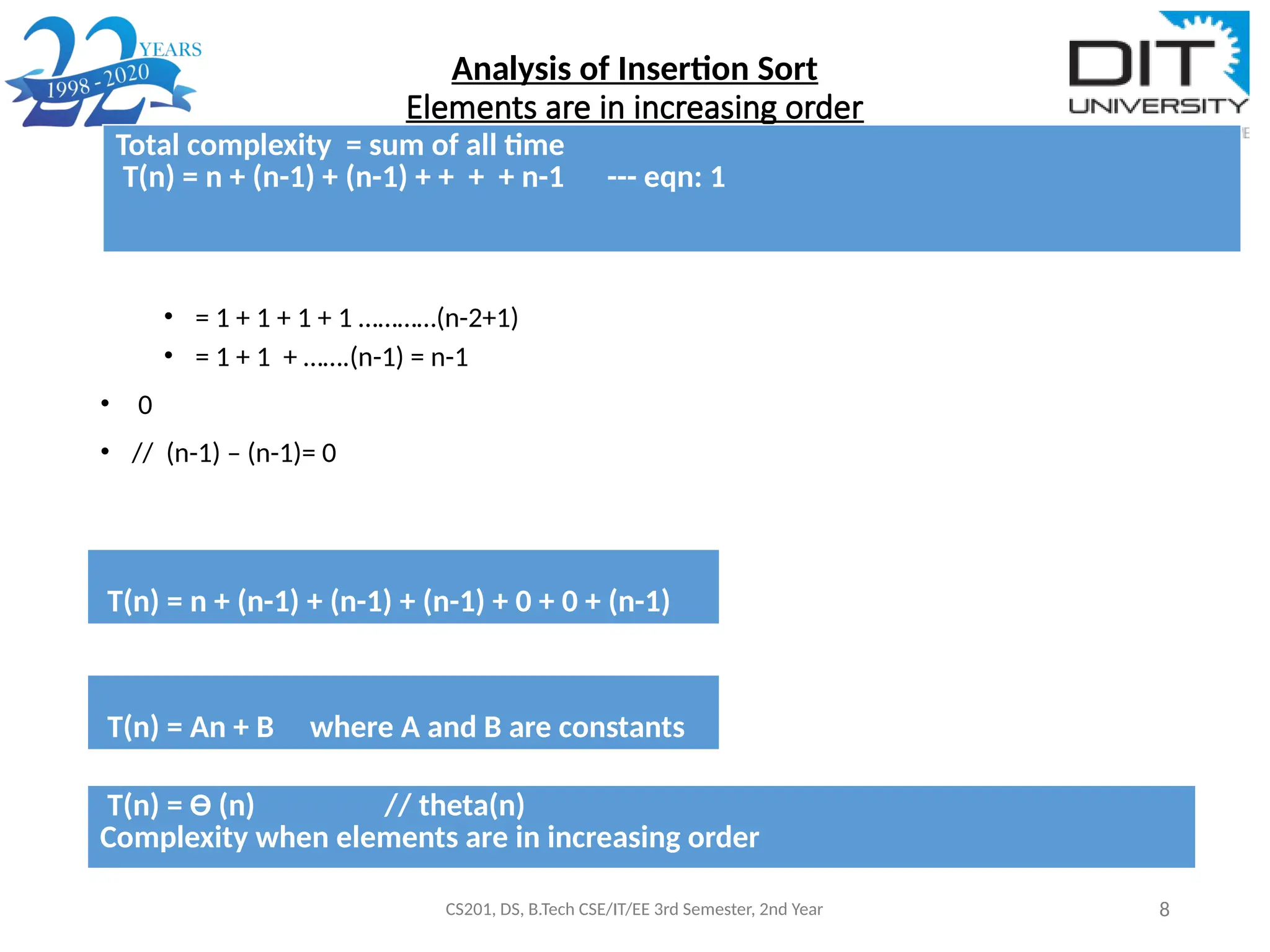
![Analysis of Insertion Sort
Elements are in decreasing order
• Case 2 : When the elements are in decreasing order
• // tj => is the number of times the while loop execute
• j =2 , key 50, i=1
• While(1>0 & key < a1) // condition true
• Shift 60 to second position, decrement i
• While (0>0 // condition false
• But again while loop execute,
• hence we can say that for j= 2 while loop execute twice
• J=3, key = 40, i= 2
• While(2>0 & key< a2) // condition true
• Shift 60 to 3rd
position and decrement i
• While ( 1>0 & key <a1) //condition true
• Shift 50 to 2nd
position, decrement i
• While( 0 > 0 // condition false
• Hence for j= 3 while loop executes thrice
Similarly for j=4 while loop executes 4 times
And so on
CS201, DS, B.Tech CSE/IT/EE 3rd Semester, 2nd Year 9
60 50 40 30 20
1 2 3 4 5
• Algorithm IS (a,n)
• { // this algo will sort the elements
of array a[], having n elements
• for ( j=2 to n)
• {
• Key = a[j] ;
• i = j – 1;
• while ( i > 0 && key < a[i])
• {
• a[i+1] = a[i];
• i = i -1 ;
• }
• a[i+1] = key;
• }
• }
50 60
1 2
40 50 60
1 2 3](https://image.slidesharecdn.com/lecture2ds-complexityis-241001013506-b8142d60/75/Lecture-2-DataStrucure-complexity-IS-pptx-9-2048.jpg)
![Analysis of Insertion Sort
Elements are in decreasing order
• = 2 +3 + 4 + ………… + n
• = { n(n+1)/2 } - 1 // sum of n natural numbers is n(n+1)/2
• [{ n(n+1)/2 } - 1 ] – (n-1) = n(n-1)/2
CS201, DS, B.Tech CSE/IT/EE 3rd Semester, 2nd Year 10
Total complexity = sum of all time
T(n) = n + (n-1) + (n-1) + + + + n-1 --- eqn: 1
T(n) = n + (n-1) + (n-1) + [{n(n+1)/2} – 1] + n(n-1)/2 + n(n-1)/2 + (n-1)
T(n) = An2
+ Bn +C where A,B and C are constants
T(n) = O (n2
) // Big-oh(n2
)
Complexity when elements are in decreasing order](https://image.slidesharecdn.com/lecture2ds-complexityis-241001013506-b8142d60/75/Lecture-2-DataStrucure-complexity-IS-pptx-10-2048.jpg)
